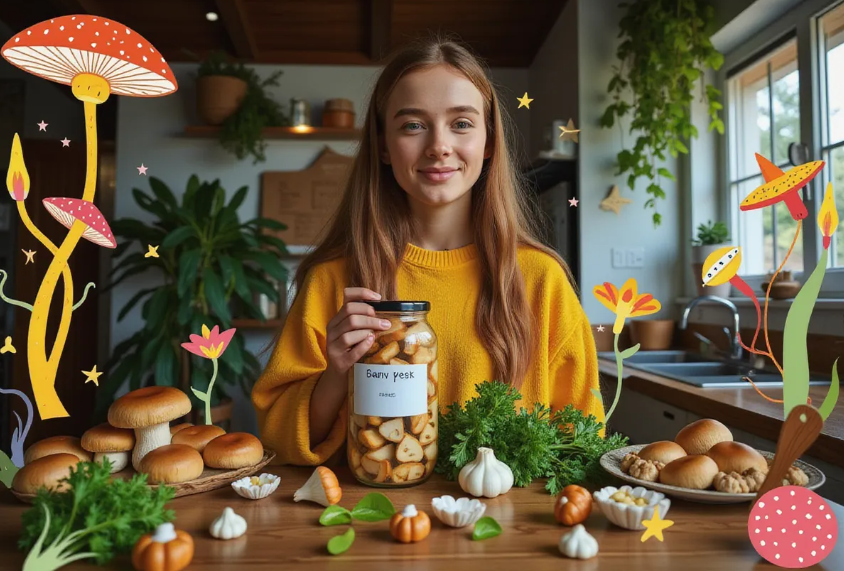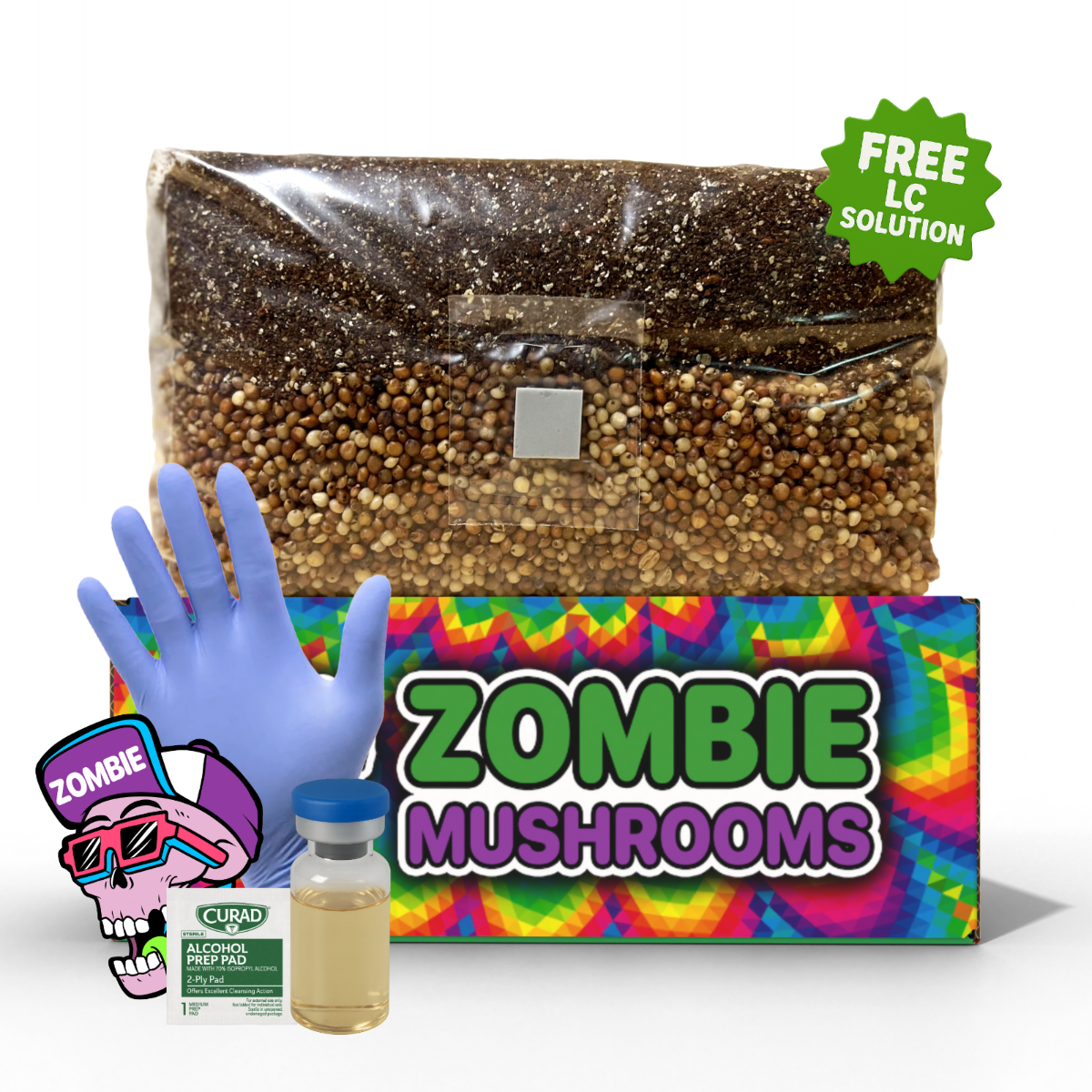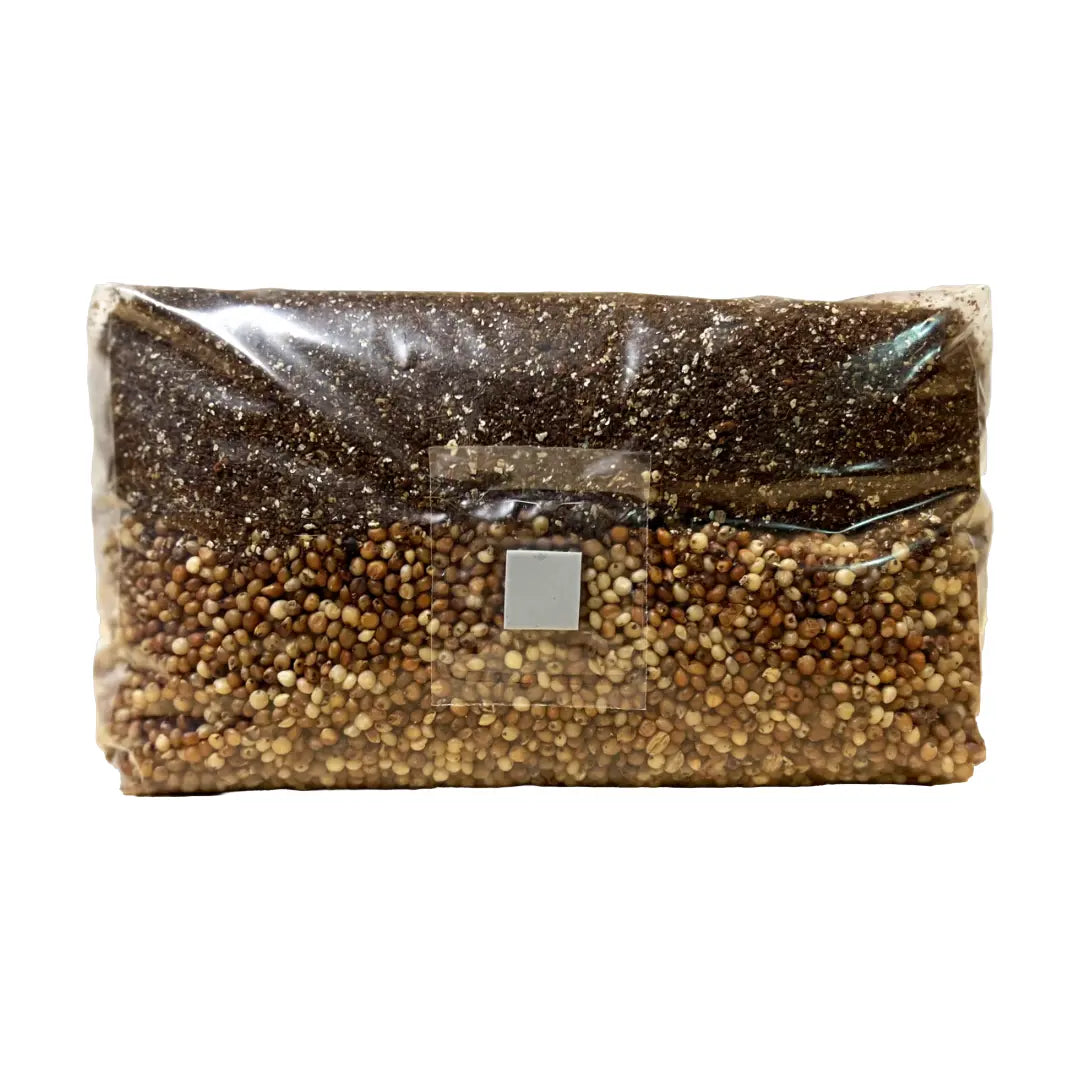⬇️ Prefer to listen instead? ⬇️
- Pickling mushrooms in acids like vinegar keeps pH below 4.6. This stops microbes and botulism risks.
- Mushroom cell walls have chitin. This keeps texture even after boiling in vinegar for a long time.
- Use only young, firm wild mushrooms to make pickles that are safe and tasty. Don’t use floppy, old, or bug-damaged ones.
- The 3:2:1 brine ratio (water : vinegar : sugar) is proven to keep acid levels safe.
- You can store pickled mushrooms in oil. But only if you treat them fully with acid first. This avoids botulism dangers.
Pickling wild mushrooms is a tasty, fun way to preserve your harvest. You can enjoy the mushrooms you find or grow at home long after picking them. If you like to cook new things, are new to foraging, or know a lot about preserving food, learning to pickle mushrooms safely and in different ways opens up many interesting, rich flavors. For the best results, it’s worth starting with fresh, firm mushrooms—whether they come from the wild or from a reliable setup using mushroom grow bags that ensure a steady supply of clean, healthy harvests. This guide will tell you all you need to know about pickling wild mushrooms: which kinds are best, and how to store, season, and serve them for the best taste and longest shelf life.

Are Pickled Wild Mushrooms Safe?
Yes, they can be safe. But safety depends on how you preserve them. The most important thing for safe mushroom pickling is acid. The USDA and food safety experts agree that most harmful tiny creatures, including Clostridium botulinum (which is dangerous and causes botulism), cannot live where the pH is below 4.6. Vinegar usually has a pH of 2–3. It is the best acid to use for pickling mushrooms.
How Vinegar Helps Keep Mushrooms
When you put mushrooms in a brine made with vinegar, you make a place where bad microbes cannot grow. The acid not only stops food from spoiling, but it also makes the flavors better. It gives the mushrooms a tart, nice taste.
Dangers of Keeping Mushrooms in Oil
It is much more risky to keep mushrooms in oil if you don’t add acid first. Oil makes a place with no oxygen. This is a good place for Clostridium botulinum to grow. To safely keep mushrooms in oil
- Pickle the mushrooms in vinegar first.
- Use tools that are cleaned and germ-free.
- Get rid of air pockets or bits of food floating on top.
- Keep it in the fridge, and eat it before it goes bad.
For trusted help, always look at the USDA Complete Guide to Home Canning and CDC Botulism Guidelines.

Picking the Right Mushrooms for Pickling
Not all mushrooms are the same for preserving. It is very important to pick the right ones for good flavor and safety.
What Good Mushrooms Are Like
Choose mushrooms that are
- Young and fresh: These stay firm when pickled.
- Firm: Mushrooms that are starting to get soft will not be good in brine. They might bring in bad bacteria.
- Without bugs or rot: If you see bugs or rot, don’t use them.
- The same size: Smaller mushrooms (under 4cm) are best. If you have bigger ones, cut them to be the same size so the brine soaks in evenly.
Don’t use mushrooms that are squishy or too old. They are not firm enough and might get worse when cooked and stored. If you have older mushrooms, think about freezing, drying, or sautéing them and then freezing them.

Best Wild Mushrooms for Pickling
Some mushrooms taste and feel better than others when pickled. Here are some of the best kinds
Chanterelles (Cantharellus spp.)
These smell fruity, like apricots. This goes well with vinegars that have other flavors added, or even dried fruit. Choose small, firm ones for the best texture.
- Flavor Tip: Add a little sweetness with apricot syrup. Or try vinegar with pineapple weed.
Hedgehog Mushrooms (Hydnum repandum)
These mushrooms stay crisp. They are good if you like pickles with texture. They have a mild nutty taste that is good with strong flavors added to the brine.
- Brine Pairing: Use soy sauce, star anise, and horseradish for a taste like food from the East.
Honey Fungus (Armillaria spp.)
Many people in Slavic countries like these. Only pick the caps when they are very young. Older ones get bitter or slimy.
- Pro Tip: Gently cook them in light vinegar with honey for a special “honied honey fungus” taste.
Saffron Milkcaps (Lactarius deliciosus)
People in Mediterranean countries like these. They are firm and colorful. These mushrooms make jars look nice and add a good bite.
- Flavor Boost: Add real saffron threads or spruce tips to make their orange color stronger and add a light woodsy taste.
Hen of the Woods (Grifola frondosa)
Also called Maitake. It is meaty and stays together well in brine.
- Flavor Idea: Add seasonings with miso or dashi for a rich, savory preserve.
Cep or Penny Bun (Boletus edulis)
This mushroom is wanted by many. It can be good for pickling if picked early when it is small and round.
- Note: Bigger cèpes get soft quickly. Dry them or cook and freeze older ones instead.
Cauliflower Fungus (Sparassis crispa)
It looks interesting and has a firm, noodle-like texture. It stays firm in vinegar.
- Best Stored With: Vinegar with conifer added or fir needles. This brings out its natural pine smell.
Wood Blewits & Trooping Funnels (Clitocybe and Lepista species)
Use these when they are firm and young. Some kinds should be boiled a little before pickling to make them safer.
- Important: If you are not sure if they are safe to eat, always pour out the water after the first boil.
Winter Chanterelles (Craterellus tubaeformis)
They are more soft than summer chanterelles. They taste good but need extra care to not spoil in oil.
- Caution: Best for keeping for a short time or eating soon.
Brittlegills: Charcoal Burners (Russula cyanoxantha)
Some Russulas are safe and tasty if prepared right. They are soft, but pickling them firmly can help.
- Must-Do: Pick when crispy, never soft.
Amanitas: Blushers (Amanita rubescens)
If you know what they are, clean them to remove toxins, and boil them a little, they can be pickled safely.
- Warning: Only for people who know a lot about foraging mushrooms. Mistaking Amanitas for other mushrooms can kill you.

Getting Wild Mushrooms Ready for Pickling
Getting mushrooms ready is very important for good results, safety, and flavor.
- Clean them well. Use a damp brush or cloth. Don’t put them fully in water. Mushrooms soak up water fast.
- Trim off bad parts, spines, or too much stem.
- Cut big mushrooms into pieces that are all the same size. This helps them pickle evenly.
- Dry them a little. Use a dehydrator or just put them in a place with air. This takes out some water inside and helps them soak up the brine better.

Why Pickling Works: Some Science
Pickling keeps food by adding acid. This stops the things that make food spoil from growing
Acid and Stopping Microbes
Mushrooms kept in a brine that is balanced right will have a pH level that stops bacteria, mold, and yeast from growing. Food Microbiology experts (Frazier & Westhoff, 1988) say that keeping the right acid level (pH ≤ 4.6) is needed for food to be preserved.
Good Mushroom Texture
Unlike cucumbers or carrots, mushroom cell walls are made of chitin instead of cellulose. This is good for texture. Chitin handles heat and acid better. This means mushrooms stay firm and chewy after pickling.

The 3-2-1 Pickling Brine Recipe
This recipe is for about 1kg of mushrooms. Change the amounts if you have more or less mushrooms.
Regular Brine Ratio
3 parts water : 2 parts vinegar : 1 part sugar
Stuff you need
- 300ml clean water
- 200ml apple cider vinegar (or white wine/rice vinegar)
- 100g granulated sugar
- 1 tsp kosher salt or pickling salt
- Optional: spices, fresh herbs, garlic, or chili
How to do it
- Mix everything in a pot and heat it gently until it just starts to bubble.
- Stir until it’s all mixed. Then add cleaned mushrooms and cook for 15–20 minutes.
- Clean jars to kill germs while it simmers (boil them or heat in oven).
- Put mushrooms and hot brine into jars. Leave a space of 1cm at the top.
- Close jars tightly while hot. Keep in fridge or keep in oil.
This ratio and cooking method makes sure the acid is right and the food is safe.
Best Vinegars for Wild Mushroom Pickling
Picking vinegar is important for both flavor and safety
Good choices
- Apple cider vinegar (balanced, natural sweet taste)
- White wine vinegar (light, nice smell)
- Rice vinegar (good with Asian spices)
Don’t use
- Balsamic: Too sweet and makes the brine dark
- Malt vinegar: Strong taste; can be too much for mushrooms
- Red wine vinegar: Makes it look bad and is too strong
You can add flavors to vinegars before using them. Use wild herbs or spices like conifer tips, ground ivy, or dandelion root. This can add interesting tastes that come from foraged things.

Make it Spicy: Flavors to Try
Regular Pickling Spices
- Bay leaves (deep, earthy taste)
- Mustard seeds (a little bite)
- Star anise (sweet spice)
- Coriander (light citrus taste)
- Black peppercorns (spicy taste at the end)
- Dried chili (for heat)
Wild Things to Add
- Horseradish root
- Fermented garlic
- Wild angelica seeds
- Ground ivy
- Wild garlic green seeds
- Pineapple weed tops
Add spices to your acid before using it. Or cook spices in the brine. This makes a strong smell and taste.

Keeping Pickled Mushrooms in Oil
Oil adds richness and helps them last longer, if done safely.
Steps
- After pickling, drain mushrooms and pat them a little to dry.
- Put them in clean jars while still hot.
- Cover them fully in oil that doesn't have a strong taste (like sunflower or light olive oil).
- Get rid of air pockets, then close tightly.
Storage: Keep in fridge and eat within 1 month. Don’t skip pickling in acid first. This stops bad things from growing before keeping them in oil where there is no air.

Safe Storage and Help Tips
- Make sure mushrooms are fully under the liquid to stop mold.
- Write the date and mushroom type on jars.
- Don’t use metal lids unless they are protected. Vinegar can damage metal.
- Throw away jars if you see bubbles, mold, or a bad smell.

Enjoying Your Pickled Wild Mushrooms
Pickled mushrooms can make any meal better
- Eat with manchego cheese and cured meats on a cheese board.
- Mix into grain bowls and salads.
- Chop and put on bruchetta with goat cheese.
- Roll into nori snacks or sushi.
- Use as a tasty garnish for drinks.
- Add to pasta sauces or risottos.

Last Thoughts: Why You Should Pickle Wild Mushrooms
Pickling wild mushrooms lets you enjoy your harvest for a long time. It mixes old ways of keeping food with new ways of cooking. Whether you want to make fancy food, waste less food from nature, or just try new tastes, pickling mushrooms is a good thing for everyone who likes mushrooms to try.
Want to grow your own mushrooms for pickling? Zombie Mushrooms' grow-at-home kits are great. They give you a way to grow mushrooms all year that are perfect for preserving.
Share your pickled mushrooms online and tag us. We want to see what you find and pickle!
Citations
- Frazier, W. C., & Westhoff, D. C. (1988). Food microbiology (4th ed.). McGraw-Hill Education.
- Oyarzabal, O. A., & Backert, S. (2011). Fundamentals of microbial food safety. Springer.



